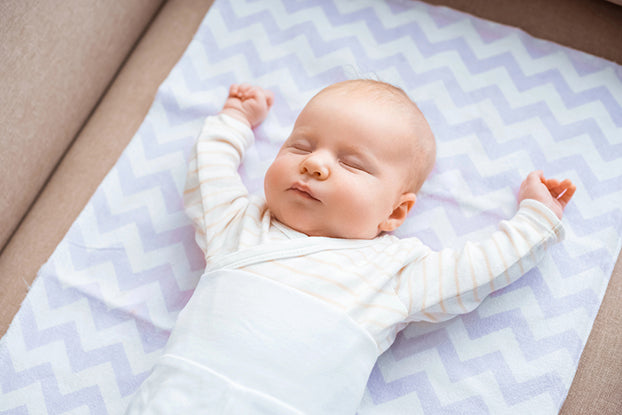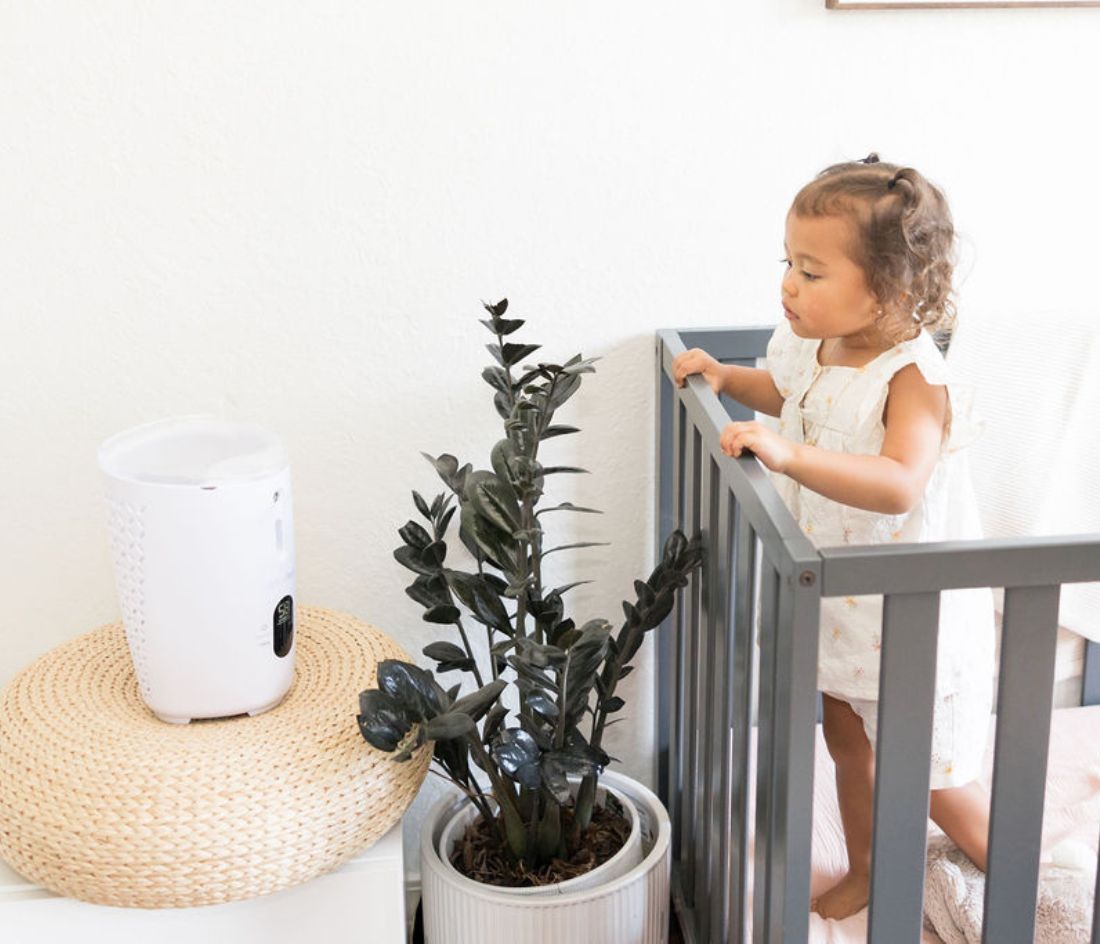Updated: February 25, 2025
Humidity levels play a big role in your baby’s comfort. More specifically, humidity for the room in which they sleep. Too much or too little humidity and your baby may feel uncomfortable to the point that they become fussy and unable to sleep.
In this article we discuss humidity for baby’s room, how it contributes to their well-being, and how to control humidity for maximum comfort.
Table Of Contents
- Why Does Humidity Matter?
- What Is The Best Humidity For Your Baby’s Room?
- Tips For Maintaining The Right Humidity In Your Baby’s Room
Why Does Humidity Matter?

Healthy Breathing
The humidity in your baby’s room can have a direct effect on the way they breathe. Air with high humidity (wet air) is “thicker” and “heavier” because of the extra water molecules floating around and can be more difficult for your baby’s new lung muscles to move in and out. On the other hand, air with low humidity (dry air) can irritate your baby’s delicate nasal passages and cause congestion — or make that congestion worse.
If your little one is congested and having a hard time breathing, consider changing the humidity in their room (see tips below) and removing the mucus with the NozeBot.
(Tip: For more info about the NozeBot, check out this article from the Dr. Noze Best blog: How to Introduce the NozeBot to Your Baby.)
Comfort
Temperature plays an important role in keeping your baby comfortable throughout the day. Pediatricians recommend setting the thermostat between 72°F and 75°F for maximum comfort. But the humidity in baby’s room can affect the actual feel of those temperatures.
High humidity can make it feel warmer than it actually is. So, for example, if the thermostat is set to 75°F but the humidity is 70%, it can feel like 77 or 78°F. That’s a bit warm for your little one’s comfort.
Similarly, low humidity can make it feel cooler than it actually is. If the thermostat is set to 72°F but the humidity is 30%, it can feel like 70°F. That might be too cool for your baby.
Maintaining the right level of humidity for your baby’s room can help you keep your little one comfortable.
Sleep
Your baby is especially susceptible to discomfort while they’re sleeping. A newborn is not able to regulate their body temperature at night as well as an older child or an adult and can become too hot or cold while they sleep.
As we touched on in the previous section, both temperature and humidity play an important part in keeping your baby comfortable. And maintaining the right humidity in baby’s room can help them sleep better at all hours of the day and night.
Our BreatheEZ Humidifier uses targeted airflow technology to deliver a soothing mist right where it is needed most while your baby is sleeping. This targeted airflow ensures the moisture is reaching the airways and not impacting the entire room which means quicker relief and extra comfort for when your little one is sleeping and need the most help.
What Is The Best Humidity For Your Baby’s Room?

When considering the best humidity for baby’s room, think of it like the fairy tale Goldilocks and the Three Bears: there’s an option that’s too high, an option that’s too low, and an option that’s just right.
Too High
Humidity above 60% is too high for most babies. Humidity this high can make the room feel hotter than it actually is and make it difficult for your little one to regulate their body temperature (something they’re not very good at yet). In addition, high humidity can promote mold, mildew, and dust mites, which might trigger an allergic reaction in some babies.
Too Low
Humidity below 30% is too low for most babies. These low levels can make the room feel colder than it actually is. Low humidity can dry out your baby’s skin and nasal passages — the latter of which can contribute to congestion and coughing. If you notice that your baby is congested and having trouble breathing, raise the humidity to a more moderate level (see next section for suggestions) and remove the mucus with gentle suction from the Dr. Noze Best NozeBot.
Just Right
Humidity that falls between 40% and 60% is just right (comfortable) for most babies, children, and adults.
Keep in mind that there is a bit of wiggle room on either side of those numbers. While the optimal level of humidity is 50%, humidity just slightly over 50% will not feel that much different from humidity that is just slightly under 50%. But, when the numbers start approaching 60%, the more you and your baby will notice the difference. Similarly, humidity just slightly under 30% will not feel that much different from humidity that is just slightly over 30%. But, when the numbers get closer to 20%, you’ll be able to tell.
Tips For Maintaining The Right Humidity In Your Baby’s Room

Clean The Humidifier Regularly
Humidifiers need to be cleaned regularly so they don’t become spreaders of mold, allergens, and bacteria. We know parents are busy and it can be difficult to keep up with the hassle of regular maintenance. That's why the BreatheEZ Humidifier was designed with your ease of use in mind! Cleaning is a breeze with the BreatheEZ humidifier. Simply remove the tank, pour out any excess water, rinse, and wipe with a towel, ensuring it is dry. Refill with water and you’re good to go in minutes! Because there is no standing water, the design of the BreatheEZ humidifier prevents mold and bacteria build up making it effortless to clean. Say goodbye to the days of throwing away humidifiers because they get moldy quickly.
A clean humidifier ensures that your child is receiving only the cleanest mist delivered to their passageways. A good way to stay on top of cleaning is to set reminders in your phone or add it to your regular chore and house maintenance list. If you see mold, bacteria, or build up, make sure to clean your humidifier immediately, even if it is before the recommended maintenance schedule. Remember that your child is breathing in what's in there, so if there is mold then that is being sprayed into the air and it can end up causing more harm than good.
Use Cool Mist Instead Of Warm Mist
Humidifiers come in two varieties: cool mist and warm mist. For regular use, choose a cool mist humidifier over a warm mist humidifier whenever possible.
Warm mist humidifiers can raise the temperature in the room (even if the humidity is at the perfect level) because they are emitting vapor that’s well above room temperature.
Cool mist humidifiers, on the other hand, use room temperature water and emit room temperature water, so you don’t have to worry about it becoming too hot in your baby’s room. In addition, cool mist humidifiers don’t rely on a heating unit to work, so they’re safer for babies who can move around their environment and reach above their heads.
Helping Your Baby Breathe Better

The humidity you maintain in your baby’s room can go a long way toward helping them breathe better — especially when they’re congested (which can happen a lot in the first few years of their life!). Maintaining a comfortable level of humidity in the living space is essential and if they’re congested and having a hard time breathing pair the humidifier use with the NozeBot to clear their nasal passages and help them feel better fast.
And, remember, a healthy baby is a happy baby!
Want more tips for keeping your baby healthy? You’ll love these articles:
- How to Monitor Your Child's Breathing At Home
- Common Mistakes Parents Make When Their Infant or Child is Sick
- Chronic Congestion vs. A Stuffy Nose: What Parents and Caregivers Need to Know
- Is It RSV, Flu, COVID-19, Or A Cold?
- Causes Of Baby Congestion (And When To Visit The Doctor)
The Nozebot is a battery-powered suction device designed to clear nasal congestion in babies and children.



